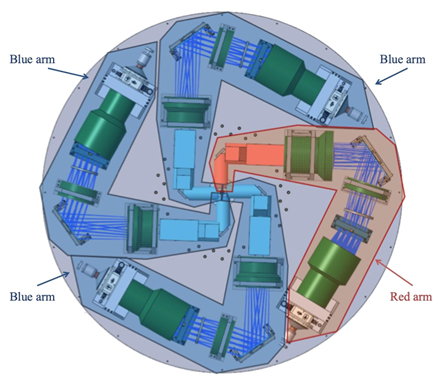TARSIS, the next generation instrument for the Calar Alto 3.5-meter telescope
UCM and IAA-CSIC co-lead TARSIS, the future instrument for the 3.5 m telescope at Calar Alto. TARSIS has unique characteristics, in particular its capacity to detect near ultraviolet light and its unprecedented field of view
Astronomical instruments allow astrophysicists to analyze the light collected by telescopes. Building new, state-of-the-art instruments is crucial to maintain any observatory at the forefront of astronomical research. This was the case for CARMENES, the instrument selected in 2009 for the Calar Alto 3.5-meter telescope, jointly led by Landessternwarte Königstuhl in Heidelberg and the Institute of Astrophysics of Andalusia (IAA-CSIC) in Granada. CARMENES has been successfully hunting exoplanets from Calar Alto since 2016.
After the publication by the observatory of a “Call for New Legacies and Instrumentation” in 2019, six instrumental projects were received and presented at IAA-CSIC during a workshop in March 2020, funded by the Spanish Network for Infrastructures in Astronomy (RIA). The Calar Alto Scientific Advisory Committee performed an in-depth review of each project and recommended two instrumental designs to be pre-selected: GAMAICA and TARSIS. Both are Integral Field Unit (IFU) spectrographs for the 3.5 m telescope and have successfully passed the feasibility study phase, once evaluated by an instrumental and Technical Advisory Committee. Based on the final recommendation by the Scientific Advisory Committee, the Calar Alto Executive Committee has just selected TARSIS as the new instrument to be constructed for the 3.5 m telescope.
TARSIS stands for Tetra-ARmed Super-Ifu Spectrograph, from its optical design based on four arms (three optimized in the blue, one in the red). It is an instrument co-led by Universidad Complutense de Madrid (UCM) and IAA-CSIC, with participation of three Andalusian universities (Almeria, Granada, and Seville), the INAOE in Mexico, industrial partner Fractal, and the Center for Astrobiology (CAB/INTA-CSIC) in Madrid. The combination of wide field of view (3 x 3 arcminutes on the sky) and high-sensitivity from ultraviolet (in the so-called UV-A range) to red wavelengths make TARSIS a unique instrument. The design of TARSIS and the exquisite transparency of the Calar Alto sky indeed makes possible observations in the full UV-A range, a domain nearly unexplored from the ground.
“Throughout the life of a Unique Science and Technology Infrastructure (ICTS) like the Calar Alto observatory, there are key moments that mark its future. One such moment was for example the development of the CARMENES spectrograph some years ago. Now, we are on the verge of a new phase that will mark the scientific and technological course of Calar Alto in the next decade, with the development of the TARSIS project,”, states Jesús Aceituno, director of the Hispanic Astronomical Center in Andalusia (CAHA, CSIC/Junta de Andalucía) at Calar Alto.

The main scientific driver of TARSIS is the study of clusters of galaxies, the largest building blocks of the Universe at large scales. With CATARSIS, its associated survey, the instrument team will fully map 16 carefully selected galaxy clusters (including the filaments that feed them with galaxies located in their surroundings), about 2 billion light-years away from Earth. TARSIS will provide both an unprecedented large field of view and high efficiency over an extended wavelength range, with a sensitivity that will allow detecting objects up to millions of times fainter than the faintest stars visible to the naked eye in a fully dark place. CATARSIS will hence be able to obtain complete spectra, gathered in one shot, of all galaxies detectable in each of the 16 selected clusters.
Jorge Iglesias, co-Principal Investigator of TARSIS, from IAA-CSIC, states that “Only the unique characteristics of TARSIS allow fully mapping galaxy clusters at distances where we can still resolve the internal structure of galaxies in a wide range of energies at the same time”. In addition to this, Armando Gil de Paz, co-Principal Investigator from the UCM, says that “TARSIS, with its unprecedented large field of view, will be the first of a kind of new generation of spectrometers that would finally allow explore in spectroscopy (that is, with information on the energy of the photons) things that until now could only be done through standard imaging.” Patricia Sánchez Blázquez, Project Scientist in charge of the CATARSIS survey, points out that “the large field of view of TARSIS and the deep planned observations of CATARIS offer major opportunities for the finding, both in the nearby and in the distant Universe, of new UV-bright objects”.
The University of Granada (UGr) is also fully committed to the project. Mónica Relaño Pastor, co-Project Scientist and UGr representative in the TARSIS consortium, points out “the relevance of CATARSIS not only to recover how galaxies form stars during their life, but also to study the influence of the environment on the formation and evolution of galaxies.”
The CATARSIS observations will allow the researchers to validate the standard cosmological model and to understand the nature of dark matter and dark energy, as well as the relationship between galaxies and their environment. Previous cosmological surveys from Calar Alto, ALHAMBRA and CALIFA, as well as the ongoing CAVITY legacy survey (the latter being led by the Galactic Astrophysics group at UGr), have been contributing to our understanding of galaxy formation and evolution mechanisms in the last years. In the next decade, CATARSIS will provide a complete dataset of 16 galaxy clusters valuable as a legacy for the astronomical community worldwide. TARSIS will also be offered to other groups in open time, making it a workhorse instrument for the 3.5 m telescope in the years to come.
Calar Alto Observatory is one of the infrastructures that belong to the national map of Unique Scientific and Technical Infrastructures (Spanish acronym: ICTS), approved on November 6th, 2018, by the Science, Technology and Innovation Policy Council.
Instituto de Astrofísica de Andalucía (IAA-CSIC)
Unidad de Divulgación y Comunicación
Silbia López de Lacalle - sll[arroba]iaa.es - 958230676
https://www.iaa.csic.es
https://divulgacion.iaa.csic.es

